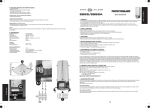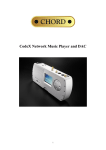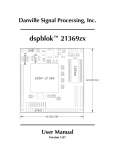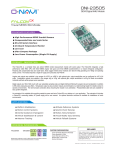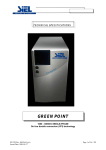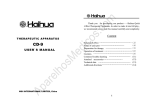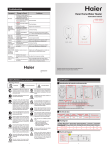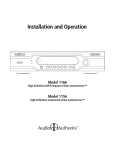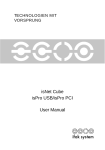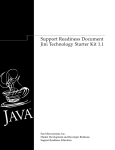Download Trilogy/HFN-Trilogy 931
Transcript
J`e^c\$\e[\[#:cXjj8_\X[g_fe\gi\Xdgc`Ô\i
DX[\Yp1Ki`cf^p8l[`fJpjk\dj#Cfe[fe
Jlggc`\[Yp1Jpdd\kip#?\ikj
K\c\g_fe\1'(.)./-,+//
N\Y1nnn%ki`cf^pXl[`f%Zfd2nnn%jpdd\kip$jpjk\dj%Zf%lb
Gi`Z\1/0,('.']figX`ek$Ôe`j_\[m\ij`fej HEADPHONE AMP
Trilogy 931
As modern headphone amplifiers go, the sleek Trilogy 931 is one of the simplest and
smartest. So does that eschewal of complication translate into superior sound quality?
Review: Keith Howard Lab: Paul Miller
H
eadphone amplifiers, once a
rare breed, are now on offer
hither and thither. To complicate
matters, they come in a variety of
guises: not just large and small, svelte and
ugly, but with or without onboard DACs,
with or without balanced headphone
outputs, with or without basic preamp
functionality, etc. Never have audiophile
consumers who enjoy – or are forced
into – headphone listening at home had
such a bewildering choice of dedicated
electronics on which to drop their money.
IT’S PURELY ANALOGUE
Trilogy’s 931 is unusually straightforward
in what it offers. A spin-off from the costlier
933, it’s identical in its core features. It
is purely analogue, so if you need D-to-A
conversion it will have to be performed
externally. It offers unbalanced inputs only,
on two pairs of phono sockets, and a single
unbalanced output via a ¼in jack socket.
So balanced signal sources and
headphones with balanced wiring are not
catered for, which is not unreasonable
given the 931’s asking price of £895 for
the standard aluminium finish. With the
eye-catching Mediterraneo Blue cover of
the review sample (finished in a paint used
by Maserati) the tariff rises to £1070 but
the result is unquestionably classy looking,
compromised only by the black Torx-head
fasteners at the top front and rear of the
wrap-around enclosure.
To the left of this is a milled-from-solid
aluminium heatsink that thankfully lacks
the sharp edges typical of off-the-shelf
finned items (and, as Trilogy points out,
their mechanical resonances too). This
hints at a high standing current in the
single-ended Class A output stage [see
box-out, p61] and verified by the 931
running quite warm, once it has been
powered for a while. I measured the
heatsink temperature as about 45°C with
the 931 mounted on an open shelf at an
ambient air temperature of 22°C, a modest
differential of 23°C.
Nevertheless it’ll pay not to site the 931
anywhere where the free flow of cooling
air is restricted. This advice is repeated in
the user manual, together with injunctions
to keep the 931 away from sources of heat
such as radiators or direct sun – to which
might be added ‘other Class A amplifiers’.
Placement on a ‘high performance
equipment platform’ is recommended, as is
the use of mains conditioning, specifically
the products of Trilogy’s sister company
Isol-8. Full performance, the manual says, is
achieved about 20 minutes after switch-on.
The 931 is pretty compact compared
to the likes of, say, the Teac HA-501 [HFN
Apr ’14] or Aurorasound Heada [HFN May
’15] but isn’t as dinky as the diminutive
Meridian Prime [HFN Feb ’14]. Deep and
narrow, it takes up little shelf width but
places the rear panel as far back as larger
equipment, which helps tidy up the wiring.
On the back panel there is an IEC
mains socket and the two pairs of phono
sockets for inputs 1 and 2 – no output is
provided, so the 931 cannot double as a
simple preamp for feeding a power amp
RIGHT: Internal layout is neat with a quality
toroidal transformer and ALPS volume control in
evidence. A pair of NPN transistors per channel
are mounted on its (left hand side) alloy heatsink
REPRODUCED FROM HI-FI NEWS | www.hifinews.co.uk
and loudspeakers. On the fascia there are
just two small toggle switches – one (left)
for power on-off and the second for input
selection – plus a volume control knob of
big enough diameter for large male fingers
to grasp easily. To the right of the volume
control is a red LED power indicator.
A NOTE OF CAUTION
Delivering a specified 800mW into
60ohm [see PM’s Lab Report, p63], the
931 is capable of rendering ample sound
pressure levels with the vast majority
of headphones, even on the short-term
transients of high dynamic range source
material. Interestingly, the 931 user
manual includes a guide to recommended
exposure times at high sound pressure
levels, and counsels the use of caution
when setting headphone listening levels.
While some buyers may resent this
as nannying, my own opinion is that it’s
a message of such importance that it
bears frequent repetition. As we face
the prospect of a generation of younger
headphone users suffering premature
hearing loss as a result of listening at
excessive SPLs for extended periods,
nobody in the audio industry should shirk
LEFT: Compact fascia
of the 931 offers
just the simplest
of controls: an on/
off switch, an input
selector switch and a
volume control knob,
with red LED power
indicator to its right
the responsibility of offering good advice
on this important topic.
In its brochure for the costlier 933
Trilogy has this to say on the subject of
headphone amplifier design: ‘The task
of moving the delicate membrane of
a headphone driver is a very different
to energising the reactive complex
impedance of a multidriver
loudspeaker. With much
less mass to move and
without the masking of
listening environment
and room interaction, the
small signal integrity of an
amplifier becomes even
more critical than that of a
regular power amplifier.’
It’s a persuasive argument and yet all
the headphone amplifiers I’ve heard have
sonic signatures which are paralleled in
power amplifiers for loudspeakers. Like
headphones themselves, some have whipcrack dynamics and the ability to deliver
minute insight into both the recording and
the musical performance, whereas others
take a step back and deliver a more relaxed
and less intimate account of events.
Of course, these are the extremes
of what is actually a spectrum of sonic
qualities but if I had to characterise the
931 as one or other I’d say it inclines a tad
to the reserved presentation. It doesn’t,
for instance, possess
the magical mix of
transparency and tonal
warmth that I so loved
in the aforementioned
Aurorasound Heada –
but at about a third of
the price it would be
unreasonable to expect
it to. The 931 delivers clean, sophisticated
sound but doesn’t quite serve up the
ultimate in resolution and excitement. For
that you probably need turn to the 933 –
though I’ve yet to hear this model.
For my listening, the 931 was fed
analogue signals from a Chord QuteHD
DAC. A second-generation Mac mini
‘I was instantly
transported back
to the fifth-form
common room’
PUSH MINUS PULL
For many years until the resurgence of single-ended triode amplifiers, the
thought of using anything other than a push-pull output stage in a power
amplifier – even a low-output Class A one for headphones – seemed bizarrely
archaic. Push-pull output stages, which I’ve likened before to a two-man saw,
have distinct technical advantages, such as improved efficiency and driving of
capacitive loads. One of these is that they cancel even-order distortion, so that
2nd, 4th, 6th, etc, harmonic and intermodulation products are significantly
reduced in the output. But in an article entitled ‘Amplifier Musicality’ [HFN Mar
’77], the legendary Jean Hiraga questioned whether this really is advantageous,
suggesting instead that a full complement of even- and odd-order distortions,
of reducing amplitude with increasing order, results in better sound quality.
Controversial as that claim remains, single-ended output stages – like that used
in the 931 – are now often favoured over the conventional push-pull alternative.
running Windows
XP and JRiver
Media Centre v19
acted as the music
server, feeding a TC
Electronic Impact
Twin FireWire audio
interface that in turn fed
S/PDIF signals to the Chord.
Headphones were an Audio-Technica
ATH-ES88 and JVC HA-SZ2000.
CLEAN AND SPACIOUS
A few weeks ago while visiting Meridian
Audio’s HQ in Huntingdon I had my
first proper opportunity to experience
MQA (Master Quality Authenticated),
Bob Stuart’s and Peter Craven’s radical
rethinking of hi-res digital audio [HFN
Apr ’15]. One of the pieces played to me
was ‘How Long Blues’ from Ray Charles’
and Milt Jackson’s Blues Brothers album.
As I revelled in the natural timbres and
uncontrived spaciousness of the recording
and luxuriated in the matchless musicality
of the performances, I found myself
wondering anew at how such fine sound
could be captured over 50 years ago.
The MQA version I’m going to have to
wait patiently to be able to experience
at home, but I snapped up the HDtracks
192kHz/24-bit download almost as soon as
I got back. I’m not claiming for a moment
that the non-MQA, headphone experience
is equally exceptional because it isn’t, but
still this is a recording which, reproduced
well, is irresistible.
And the 931 did a very creditable job
of conveying all its fine qualities. Spacious,
detailed and natural, its sound was only a
couple of notches down on the best I’ve
heard from a headphone amplifier at any
price. While it didn’t quite serve up the
ultimate in image dimensionality or sheer
resolution, you’d have to have heard or
owned a very high-end amp to perceive
any shortfall. The overwhelming imperative
was just to sit back and enjoy.
Another new acquisition chez Howard
is something I never imagined buying – the
Higher Ground Hurricane Relief Benefit
www.hifinews.co.uk | REPRODUCED FROM HI-FI NEWS
LAB
REPORT
TRILOGY 931
ABOVE: No digital inputs here as the Trilogy 931 is analogue from input to output.
Two RCA ins are offered, switchable via a toggle on the front panel
Concert [EMI/Blue Note 0946 3
45238 2 0] – until I heard one track
from it and simply had to acquire it:
Norah Jones’ live performance (just
voice and piano) of ‘I Think It’s Going
To Rain Today’. This is far and away
the best version I’ve ever heard of
the Randy Newman protest song,
so apposite in the context of the
New Orleans disaster and a perfect
showcase for Jones’ velvet voice.
BACK TO THE CLASSROOM
Again the 931 delivered the
essential qualities of what is only a
44.1kHz/16-bit recording but the
best sounding track on the CD.
Unadorned with unnecessary EQ
and unfettered by any noticeable
dynamic range compression (there
is just a little limiting on peaks), it’s
a modern demonstration of ‘less is
more’ that the Trilogy did little to
impede. Once again the sound was
spacious, clean and blessed with
wide dynamic range. I bet many
there at the Lincoln Center that
day in 2005 didn’t experience it
sounding this good.
My classical music selection
included part of Tchaikovsky’s
Serenade For Strings played by the
Scottish Ensemble [Linn Records
CKD 472], a free 44.1kHz/16-bit
download via the Hyperion Records
monthly sampler in March. This isn’t
the clearest or the airiest recording
you’ll ever hear – probably it sounds
significantly better in its hi-res
versions [see review HFN Aug ’15]
– and the muscular opening with
its big chords might have benefited
from more resolving power than the
931 brings to bear. But this reserve
is part of the 931’s core makeup.
As I’ve probably recounted
before, I don’t spend much time
listening to the soundtracks of my
youth. My salad days, when I was
green in judgment have, I hope,
been superseded by a better and
broader musical taste. But certain
albums from that period do exert an
almost gravitational pull, and earn a
place in my collection because of it.
I’ve never owned the eponymous
Santana album previously – Abraxas
made the bigger impression on the
16-year-old me – but I remember
it being played endlessly in school
when I was studying for O-levels, and
so when I saw HDtracks’ download
of it recently I succumbed.
Nobody is ever going to call
this an audiophile recording, even
at 96kHz/24-bit, any more than
Abraxas is – but that heady mix of
Latin rhythm and heavy rock still
casts its spell. Via the 931, ‘Jingo’
proved as evocative as the scent
of a summer evening: the bass was
deeper than I ever heard in 1969/70
and the percussion crisper, but I was
transported straight back to the
fifth-form common room.
This is a perfect blue-sky opportunity for a single-ended/
single-transistor (necessarily Class A) output stage designed
to drive a load that’s less taxing/current hungry than a fullyfledged loudspeaker. The A-wtd S/N ratio is adequate at 88.2dB
(re. 0dBV) and the 800mW/60ohm specification is met by
the 500mW/25ohm measured in my lab (assuming a current
limit of 0.14A). The maximum 10.22V output available for
high impedance ’phones is equivalent to 350mW/300ohm.
However, innovative though this single-transistor stage is, there
remains some thermal drift: its maximum power output falling
to 445mW/25ohm once the unit is on and ‘cooking’ after an
hour or so [see Graph 1, below].
Distortion otherwise follows a consistent pattern,
increasing gently with output from 0.002% at 10mW, 0.006%
at 100mW, 0.01% at 300mW and 0.02% at 400mW/25ohm.
Distortion increases at low bass frequencies under load from
0.003%/20Hz at 1V/1kohm to 0.0065%/20Hz at 1V/25ohm
(40mW) and to 0.05% at 5Hz [see shaded traces, Graph 2].
This is mirrored by a load-dependent bass roll-off that increases
with reducing headphone impedance, reaching –1.7dB/20Hz
at 40mW/25ohm [see responses, Graph 2]. Of course, with the
excessive bass output exhibited by many headphones, this is
no bad thing. The ultrasonic response meanwhile stretches out
to 100kHz ±0.05dB. Furthermore the fabulously low <1ohm
source impedance minimises any chance of further amp/’phone
response variations. Readers may view a comprehensive QC
Suite test report for Trilogy’s 931 headphone preamp by
navigating to www.hifinews.co.uk and clicking on the red
‘download’ button. PM
ABOVE: Continuous power output vs. distortion into
25ohm ‘headphone’ load (black, cold; red when ‘hot’)
HI-FI NEWS VERDICT
The Trilogy 931 is a good looking,
well-constructed and finesounding headphone amp, albeit
one which hasn’t the ultimate
transparency and spatiality to
trade punches with the very best.
It lacks bells and whistles but
for many potential buyers it has
everything they need, making its
simplicity a virtue along with its
compactness compared to certain
competitors. And for patriotic
Brits, it’s made in the UK.
Sound Quality: 81%
0
-
-
-
-
-
-
-
- 100
ABOVE: Freq. resp. from 5Hz-100kHz (black) and into
25ohm (dashed) with distortion versus frequency
(red, 1V; shaded, 40mW) from 5Hz-40kHz
HI-FI NEWS SPECIFICATIONS
Maximum output (re. 1% THD into 47kohm)
10.22V
Max. power output (re. 1% THD into 25ohm)
498mW (445mW, hot)
Output Impedance (20Hz-20kHz)
0.9-0.9ohm
Maximum gain
+20.4dB
A-wtd S/N ratio (re. 0dBV)
88.2dB
Frequency response (20Hz-20kHz/25ohm)
–1.7dB to +0.00dB
Distortion (20Hz-20kHz, re. 40mW)
0.0045-0.0065%
Power consumption
12W
Dimensions (WHD) / Weight
140x50x244mm / 1.6kg
www.hifinews.co.uk | REPRODUCED FROM HI-FI NEWS






